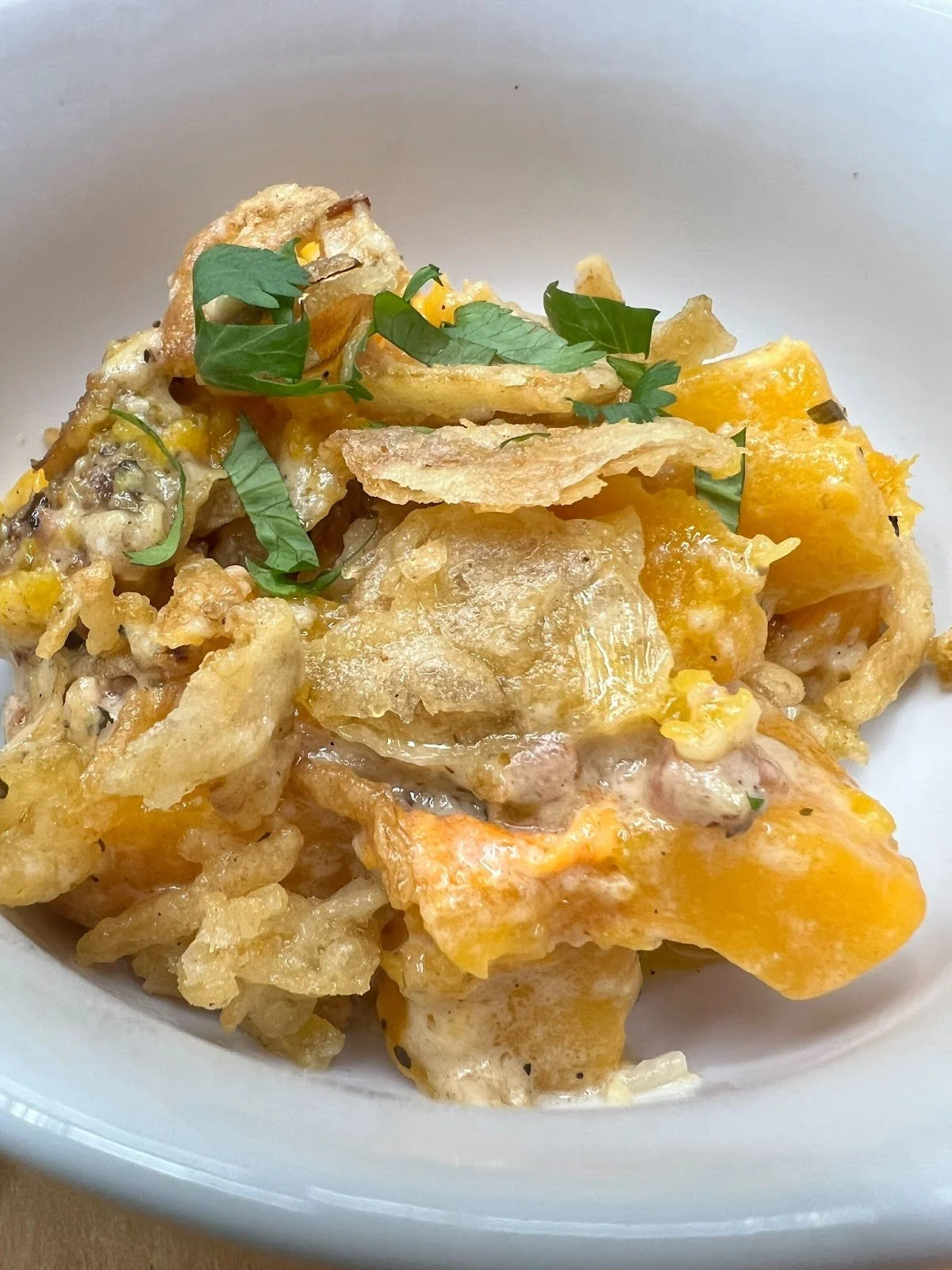Squash season: Learn how to plant, grow and cook squash from the CSU Extension office and food writer Emily Kemme
The smooth-textured butternut squash is versatile, low calorie and loaded with vitamins and minerals. It seems daunting to cut through its outer skin, but there’s a simple technique that makes it easy. Photo by Emily Kemme.
By Emily Kemme
This growing season has been relatively successful for me, if what you count for vegetable sustenance is a bountiful crop of serrano and jalapeño peppers, a couple handfuls of stunted poblanos and a copious amount of sweet cherry tomatoes.
But for those of us who know we can’t live on salsa alone — much as we might try — and who struggle to produce little more than a hill of beans in our home gardens, it’s useful knowing there is strength in numbers.
In sharing the ancient concept of the Three Sisters — a companion method of planting corn, climbing beans and squash together — Indigenous people along the eastern coast of the United States helped Europeans survive the intemperate North American climate by teaching the colonists new ways of planting.
The Iroquois and Seneca women in what is now the state of New York practiced a mixed crop planting system, building hills or small mounds to plant rows of corn kernels. Next came beans and finally, they planted low-growing crops of squash or pumpkins beneath the beans and corn. Planting each distinct crop was separated by several weeks.
While the practice had cultural symbolism — “in planting the corn the seeds of the squash and bean were sown in every seventh hill because it was thought that the spirits of these three plants were inseparable” and, called Diohe’ko, sustained a tribe, there was a more practical aspect to this farming method.
The system worked so that each plant protected the other: beans were cultivated several weeks after corn was planted and those two vegetables developed a shared ecosystem. The cornstalks drew nitrogen from the soil which had been deposited there from the beans as they grew, and the stalks supported the beans’ climbing tendrils.
Below it all, the gourds’ leafy greens carpeted the earth, preventing the sun from baking out precious water and limiting the ability of weeds to grow.
The Colorado State University Extension 4-H programs offers steps to incorporate this ancient planting method into modern farming.
Pumpkins are one squash that can be propagated with this method, but another is the oblong, smooth textured butternut squash.
Because its outer skin is tough — even more so than a pumpkin — preparing butternut squash might seem daunting.
As it turns out, it’s not that difficult to prepare for a recipe.
Armed with a sharp chefs knife, slice the squash into workable sections. Grip it firmly in one hand and cut off the top and bottom to create a flat surface, stabilizing the squash for the next steps. Remove the outer skin in thin strips, working from top to bottom. Slice the squash in half from the stem end and scoop out the seeds and stringy flesh with a spoon.
Butternut Squash Casserole is a savory recipe that’s perfect for cool, autumn nights and holiday tables. Photo courtesy of Chef Jason Morse.
Dice into firm, orange pieces to create a variety of dishes. It’s worth the small amount of effort spent in preparation.
Low in calories and loaded with vitamins (particularly vitamins A and C) and minerals to boost immune system health and maintain healthy bones, its sweet nutty flavor and the fact that it’s easy to purée into golden smoothness makes butternut squash a recipe favorite.
The Colorado Department of Agriculture’s featured vegetable this month is butternut squash. Chef Jason Morse of 5280 Culinary created a casserole with this savory veggie that’s perfect for cool, autumn nights and can be a tasty addition to a holiday table.
Butternut Squash Casserole
Yield: Serves 6-8 people
Prep time: 15 minutes
Freeze time: 1 - 1 1/4 hours
Ingredients:
4 oz pancetta, diced small
2 medium shallots, diced small
2 1/2 lbs butternut squash, washed and peeled, diced large
Kosher salt to taste
Fresh ground pepper to taste
1/2 tsp Italian herbs, dried
2 tbsp salted butter
2-3 tbsp all-purpose flour
1/2 cup heavy cream
1/2 cup parmesan cheese, shredded
1/2 cup Gruyere cheese, shredded
1 cup fried onions, chopped
Chopped fresh Italian parsley for garnish
Directions:
Preheat the oven to 400℉.
Heat a large, oven-safe sauté pan or cast iron skillet over medium high heat.
Add the pancetta and cook until lightly browned.
Add the onion and sauté until lightly browned.
Add butternut squash, salt, pepper, Italian herbs and butter. Stir and cook for 5 minutes.
Sprinkle flour over the mixture and cook for 1-2 minutes.
Add the cream and both shredded cheeses. Cook and stir until combined and thickened. Remove from the heat.
Cover the pan with lid or foil and cook in the preheated oven for 60-75 minutes or until squash is tender. Check for doneness at approximately 45 minutes.
Once squash is tender, uncover and add fried onions to the top. Cook for 5 additional minutes to crisp onions.
10. Carefully remove the pan from the oven (using heat proof gloves), place onto a heat proof surface and allow to cool for 5 minutes before serving.
11. Sprinkle with fresh parsley to garnish.
12. DEVOUR!
Recipe courtesy of Chef Jason K. Morse, C.E.C., 5280 Culinary, LLC and Ace Hardware Grill Expert


